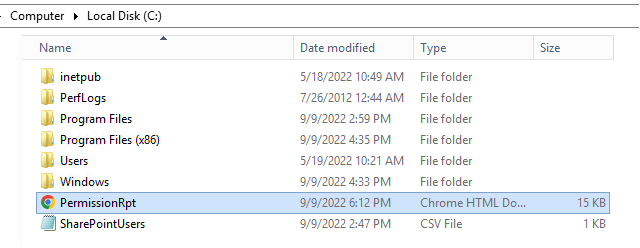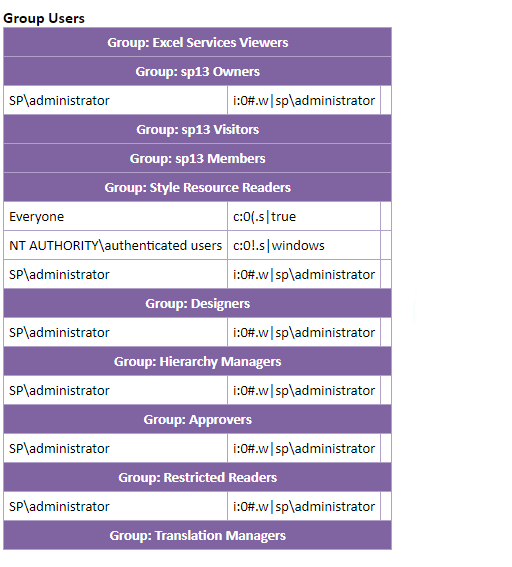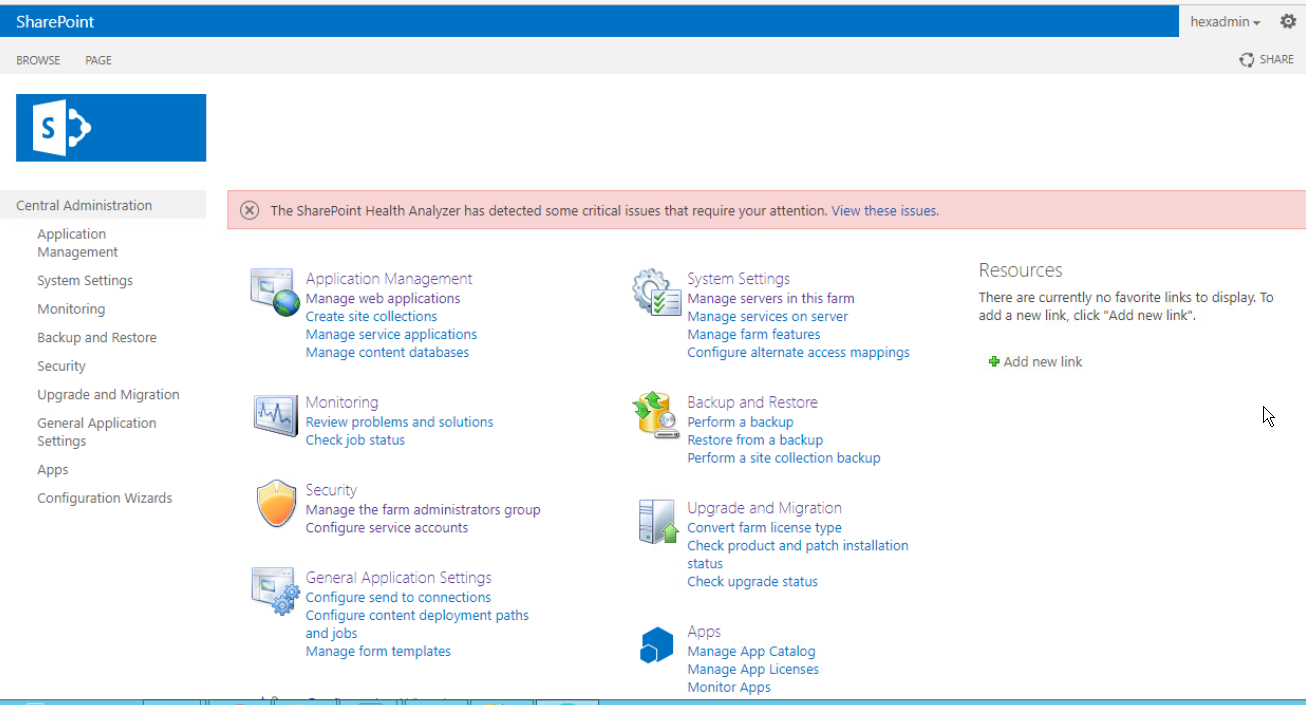
Hi @dirkdigs ,
I have implemented the below PowerShell script to list all the users across the site collections to list all the users with their group names iteratively.
Please replace site collection URL and run the following code with SharePoint 2013 management shell:
Add-PSSnapin Microsoft.SharePoint.PowerShell -ErrorAction SilentlyContinue
$HTMLTemplate=@"
<html>
<head>
<!-- Sal - Javascript Function to apply formatting -->
<script type="text/javascript">
function altRows(id){
if(document.getElementsByTagName){
var table = document.getElementById(id);
var rows = table.getElementsByTagName("tr");
for(i = 0; i < rows.length; i++){
if(i % 2 == 0){
rows[i].className = "evenrowcolor";
}else{
rows[i].className = "oddrowcolor";
}
}
}
}
window.onload=function(){
altRows('alternatecolor');
}
</script>
<!-- CSS Styles for Table TH, TR and TD -->
<style type="text/css">
body{ font-family: Calibri; height: 12pt; }
table.altrowstable {
border-collapse: collapse; font-family: verdana,arial,sans-serif;
font-size:11px; color:#333333; border-width: 1px; border-color: #a9c6c9;
border: b1a0c7 0.5pt solid; /*Sal Table format */
}
table.altrowstable th {
border-width: 1px; padding: 5px; background-color:#8064a2;
border: #b1a0c7 0.5pt solid; font-family: Calibri; height: 15pt;
color: white; font-size: 11pt; font-weight: 700; text-decoration: none;
}
table.altrowstable td {
border: #b1a0c7 0.5pt solid; font-family: Calibri; height: 15pt; color: black;
font-size: 11pt; font-weight: 400; text-decoration: none;
}
.oddrowcolor{ background-color: #e4dfec; }
.evenrowcolor{ background-color:#FFFFFF; }
</style>
</head>
<body>
"@
#Function to get permissions of an object Sal. Such as: Web, List, Folder, ListItem
Function Get-Permissions([Microsoft.SharePoint.SPRoleAssignmentCollection]$RoleAssignmentsCollection, $OutputReport)
{
foreach($RoleAssignment in $RoleAssignmentsCollection)
{
#Get the Permissions assigned to Group/User
$UserPermissions=@()
foreach ($RoleDefinition in $RoleAssignment.RoleDefinitionBindings)
{
#Exclude "Limited Access" - We don't need it sal.
if($RoleDefinition.Name -ne "Limited Access")
{
$UserPermissions += $RoleDefinition.Name +";"
}
}
if($UserPermissions)
{
#*** Get User/Group Name *****#
$UserGroupName=$RoleAssignment.Member.Name
$UserName=$RoleAssignment.Member.LoginName
#**** Get User/Group Type ***** Is it a User or Group (SharePoint/AD)?
#Is it a AD Domain Group?
If($RoleAssignment.Member.IsDomainGroup)
{
$Type="Domain Group"
}
#Is it a SharePoint Group?
Elseif($RoleAssignment.Member.GetType() -eq [Microsoft.SharePoint.SPGroup])
{
$Type="SharePoint Group"
}
#it a SharePoint User Account
else
{
$Type="User"
}
#Send the Data to Report
" <tr> <td> $($UserGroupName) </td><td> $($Type) </td><td> $($UserName) </td><td> $($UserPermissions)</td></tr>" >> $OutputReport
}
}
}
Function Generate-PermissionRpt()
{
Param([Parameter(Mandatory=$true)] [string]$SiteCollectionURL,
[Parameter(Mandatory=$true)] [string]$OutputReport,
[Parameter(Mandatory=$true)] [bool]$ScanFolders,
[Parameter(Mandatory=$true)] [bool]$ScanItemLevel)
#Try to Get the site collection
try
{
$Site = Get-SPSite $SiteCollectionURL -ErrorAction SilentlyContinue
}
catch
{
write-host Site Collection with URL:$SiteCollectionURL Does not Exists!
return
}
#Append the HTML File with CSS into the Output report
$Content = $HTMLTemplate > $OutputReport
"<h2> Site Collection Permission Report: $($Site.RootWeb.Title) </h2>" >> $OutputReport
#Table of Contents
"<h3> List of Sites</h3> <table class='altrowstable' id='alternatecolor' cellpadding='5px'><tr><th>Site Name </th><th> URL </th><th> Permission Setup </th></tr>" >> $OutputReport
#Get Users of All Webs : Loop throuh all Sub Sites
foreach($Web in $Site.AllWebs)
{
if($Web.HasUniqueRoleAssignments -eq $true)
{
$PermissionSetup ="Unique Permissions"
}
else
{
$PermissionSetup="Inheriting from Parent"
}
"<tr> <td> <a href='#$($web.Title.ToLower())'>$($web.Title)</a> </td><td> $($web.URL)</td> <td> $($PermissionSetup)</td></tr>" >> $OutputReport
}
#Site Collection Administrators Heading
"</table><br/><b>Site Collection Administrators</b>" >> $OutputReport
"<table class='altrowstable' id='alternatecolor' cellpadding='5px'><tr>" >> $OutputReport
#Write Table Header
"<th>User Account ID </th> <th>User Name </th></tr>" >> $OutputReport
#Get All Site Collection Administrators
$Site.RootWeb.SiteAdministrators | sort $_.Name | ForEach-Object {
"<tr><td> $($_.LoginName) </td> <td> $($_.Name)</td></tr> " >> $OutputReport
}
$Counter=0;
#Get Users of All Webs : Loop throuh all Sub Sites
foreach($Web in $Site.AllWebs)
{
Write-Progress -Activity "Collecting permissions data. Please wait..." -status "Processing Web: $($Web.URL)" -percentComplete ($Counter/$Site.AllWebs.count*100)
#Check if site is using Unique Permissions or Inheriting from its Parent Site!
if($Web.HasUniqueRoleAssignments -eq $true)
{
"</table><br/><hr> <h3>Site: <a name='$($Web.Title.ToLower())' href='$($web.URL)' target='_blank'>$($Web.Title)</a> is using Unique Permissions. </h3>" >> $OutputReport
}
else
{
"</table><br/><hr> <h3>Site: <a name='$($Web.Title.ToLower())' href='$($web.URL)' target='_blank'>$($Web.Title)</a> is Inheriting Permissions from its Parent Site.</h3>" >> $OutputReport
}
#Get the Users & Groups from site which has unique permissions - TOP sites always with Unique Permissions
if($Web.HasUniqueRoleAssignments -eq $True)
{
Write-host Processing Web $Web.URL
#*** Get all the users granted permissions DIRECTLY to the site ***
"<b>Site Permissions</b><table class='altrowstable' id='alternatecolor' cellpadding='5px'><tr>" >> $OutputReport
"<th>Users/Groups </th> <th> Type </th><th> User Name </th> <th>Permissions</th></tr>" >> $OutputReport
#Call the function to get Permissions Applied
Get-Permissions $Web.RoleAssignments $OutputReport
#****** Get Members of Each Group at Web Level *********#
"</table></br> " >>$OutputReport
#Check if any SharePoint Groups Exists, if yes, Get members of it
$WebGroupRoleAssignments = $Web.RoleAssignments | Where { $_.Member.GetType() -eq [Microsoft.SharePoint.SPGroup]}
if($WebGroupRoleAssignments)
{
"<b>Group Users</b><table class='altrowstable' id='alternatecolor' cellpadding='5px'><tr>" >>$OutputReport
foreach($WebRoleAssignment in $WebGroupRoleAssignments)
{
"<th colspan='3'><b>Group:</b> $($WebRoleAssignment.Member.Name)</th></tr> " >> $OutputReport
foreach($user in $WebRoleAssignment.member.users)
{
#Send the Data to Log file
" <tr> <td> $($user.Name) </td><td> $($user.LoginName) </td><td> $($user.Email)</td><tr>" >> $OutputReport
}
}
}
} #Web.HasUniqueRoleAssignments Over
#******** Check All List's Permissions ********/
foreach($List in $Web.lists)
{
#Skip the Hidden Lists
if( ($List.HasUniqueRoleAssignments -eq $True) -and ($List.Hidden -eq $false))
{
"</table><br/><b>List: [ $($List.Title) ] at <a href='$($List.ParentWeb.Url)/$($List.RootFolder.Url)'>$($List.ParentWeb.Url)/$($List.RootFolder.Url)</a> is using Unique Permissions.</b><table class='altrowstable' id='alternatecolor' cellpadding='5px'><tr>" >> $OutputReport
"<th>Users/Groups </th><th> Type </th><th> User Name </th><th> Permissions</th></tr>" >> $OutputReport
#Call the function to get Permissions Applied
Get-Permissions $List.RoleAssignments $OutputReport
}
"</table>" >>$OutputReport
#******** Check Folders with Unique Permissions ********/
if($ScanFolders -eq $True)
{
$UniqueFolders = $List.Folders | where { $_.HasUniqueRoleAssignments -eq $True }
#Check if any folder has Unique Permission
if($UniqueFolders)
{
#Get Folder permissions
foreach($folder in $UniqueFolders)
{
#Write Table Headers
$FolderURL=$folder.ParentList.ParentWeb.URL+"/"+$folder.Url
"<br/><b>Folder: <a href='$($FolderURL)' target='_blank'>$($Folder.Title)</a> is using Unique Permissions.</b><table class='altrowstable' id='alternatecolor' cellpadding='5px'><tr>" >> $OutputReport
"<th>Users/Groups </th><th> Type </th><th> User Name </th><th> Permissions</th></tr>" >> $OutputReport
#Call the function to get Permissions Applied
Get-Permissions $folder.RoleAssignments $OutputReport
"</table>" >>$OutputReport
}
}
}
#******** Check Items with Unique Permissions ********/
if($ScanItemLevel -eq $True)
{
$UniqueItems = $List.Items | where { $_.HasUniqueRoleAssignments -eq $True }
#Check if any Item has Unique Permission Sal
if($UniqueItems)
{
#Get Folder permissions
foreach($Item in $UniqueItems)
{
#Get Item's Name if Title is NULL
if($Item.Title -ne $null) {$ItemTitle = $Item.Title } else {$ItemTitle= $Item["Name"] }
#Write Table Headers
$ItemURL= $item.ParentList.ParentWeb.Site.MakeFullUrl($item.ParentList.DefaultDisplayFormUrl)
"<br/><b>Item: <a target='_blank' href='$($ItemURL)?ID=$($Item.ID)'>$($ItemTitle)</a> in list/library <a href='$($List.ParentWeb.Url)/$($List.RootFolder.Url)'>$($List.Title) </a> is using Unique Permissions.</b><table class='altrowstable' id='alternatecolor' cellpadding='5px'><tr>" >> $OutputReport
"<th>Users/Groups </th><th> Type </th><th> User Name </th><th> Permissions</th></tr>" >> $OutputReport
#Call the function to get Permissions Applied
Get-Permissions $Item.RoleAssignments $OutputReport
"</table>" >>$OutputReport
}
}
}
} #List
$Counter=$Counter+1;
} #Web
"</body></html>" >>$OutputReport
Write-host "`n Permission report generated successfully at "$OutputReport
}
#**********Configuration Variables************
$OutputReport = "C:\PermissionRpt.htm"
$SiteCollURL="https://xxx"
$ScanFolders=$False
$ScanItemLevel=$False
#Call the function to Get Permissions Report
Generate-PermissionRpt $SiteCollURL $OutputReport $ScanFolders $ScanItemLevel
The result of running is as follows:


If the answer is helpful, please click "Accept Answer" and kindly upvote it. If you have extra questions about this answer, please click "Comment".
Note: Please follow the steps in our documentation to enable e-mail notifications if you want to receive the related email notification for this thread.

